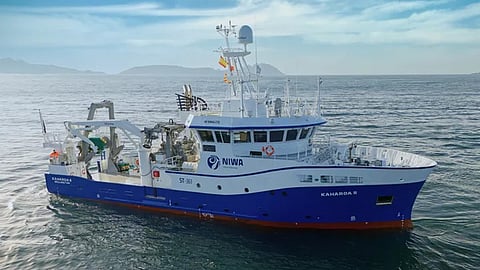VESSEL REVIEW | Kaharoa II – Fully-equipped research vessel for New Zealand science institute
A new research vessel was recently handed over to the National Institute of Water and Atmospheric Research of New Zealand (NIWA).
Kaharoa II was built by Armon Shipyard of Spain to a design by Norwegian naval architecture firm Skipsteknisk to replace an older, slightly smaller similarly named vessel that has been in service for more than 40 years. Design work was completed in compliance with DNV class rules including the Silent-A and Silent-F notations.
The newbuild has an LOA of 36.1 metres (118 feet), a moulded beam of 9.5 metres (31 feet), a draught of 3.65 metres (12 feet), a depth of 4.7 metres (15 feet), a gross tonnage of 492, and accommodation for six crewmembers and up to nine scientists. The onboard facilities include wet and dry laboratories of more than 12 square metres (130 square feet) each, a conference room, and five cabins. The aft deck has a total area of 85 square metres (910 square feet) for the transport of additional equipment.
Reduced noise and emissions for low-impact research voyages
A Yanmar Y6N21AW 956kW (1,280hp), IMO Tier III main diesel engine drives a Finnøy five-bladed, controllable-pitch propeller via a Finnøy G50FK two-speed gearbox fitted on a flexible mount. This arrangement can deliver a top speed of 12 knots and a range of 6,500 nautical miles at a cruising speed of 10 knots. Alternatively, the vessel can stay out at sea for a maximum of 30 days.
The propeller generates only minimal underwater noise, thus permitting data collection through echosounders to be conducted with greater accuracy and with little adverse impact on the surrounding marine life.
Comprehensive equipment suite
The deck equipment includes a net drum and electrically-driven trawl and oceanographic winches supplied by Ibercisa. A Scantrol autotrawl system will meanwhile aid in fish sampling activities. The acoustic equipment from Kongsberg includes echosounders, a hydro-acoustic positioning system, a sub-bottom profiler, a dynamic positioning system, and a position, attitude, time and heading (PATH) sensor. Also fitted are two Furuno radars and satellite communications equipment from Intellian.
The winches consist of research winches, a piston coring winch (combined with trawl), an oceanographic winch, and a combined camera/CTD/acoustic winch with active heave compensation (AHC). These will enable the vessel to undertake fishery and trawl surveys to a depth of 600 metres (2,000 feet) and oceanography up to 6,500 metres (21,000 feet).
To permit continuous operation even in challenging and variable sea conditions in the southern Pacific Ocean, AHC will ensure that the winches can work under adverse weather conditions.
Ibercisa also supplied the vessel’s A-frame, the side T-frame, and the launch and recovery system (LARS) for use by smaller robotic vehicles.
Supporting local and global initiatives
Kaharoa II sailed on its maiden operational voyage in New Zealand’s Hauraki Gulf Marine Park over a period of three weeks from August 27 to September 10 to film underwater habitats. The research was done by NIWA on behalf of Fisheries New Zealand and was supported by the Department of Conservation and Seafood New Zealand. The voyage focused on seafloor communities across reefs, sand, and mud habitats in what is one of New Zealand’s most valued and intensively used coastal spaces.
Kaharoa II will also support Seabed 2030, an international effort to map the world’s ocean floor, and the Argo programme, a global ocean monitoring initiative involving more than 30 countries. The vessel will also help maintain New Zealand’s tsunami detection network.


